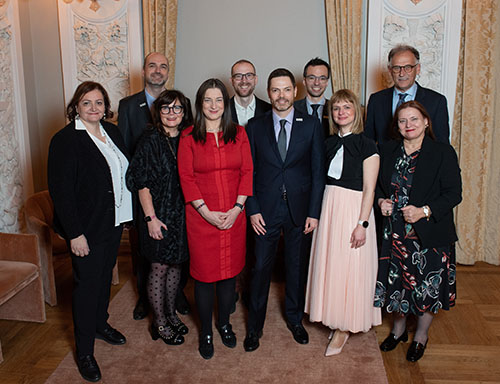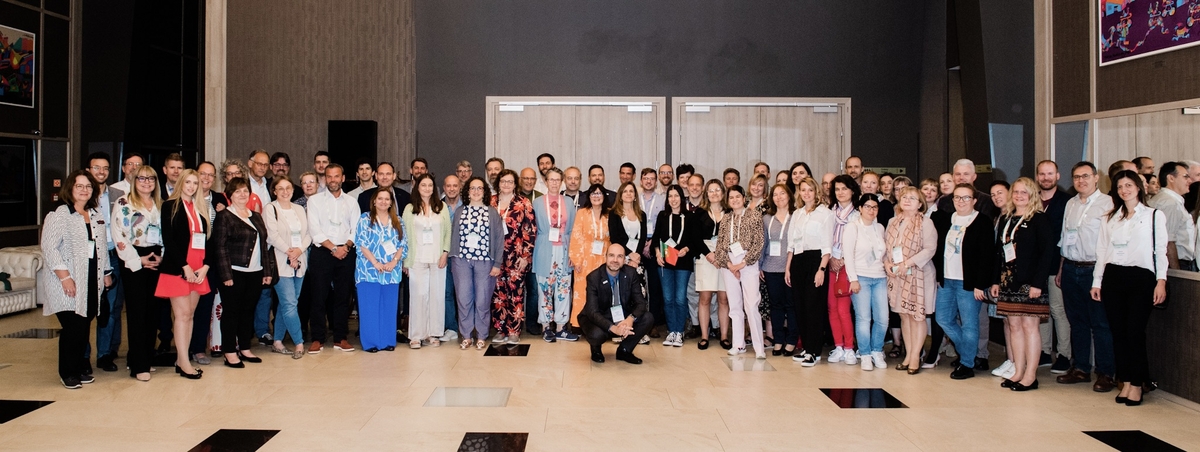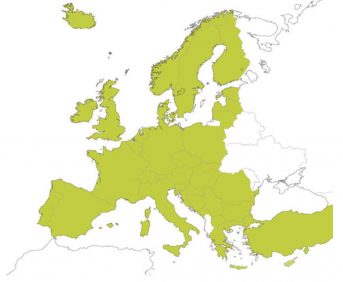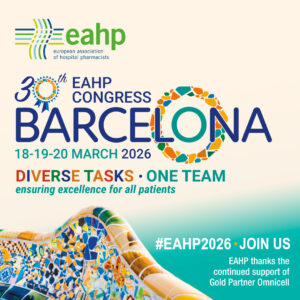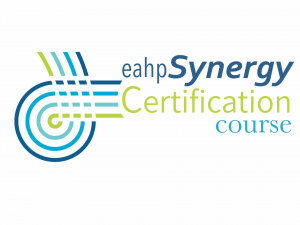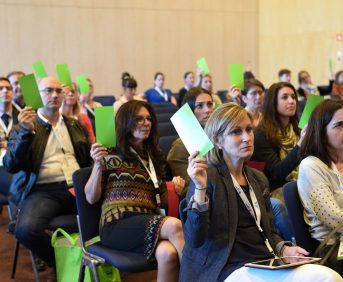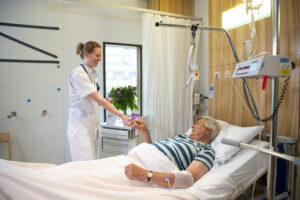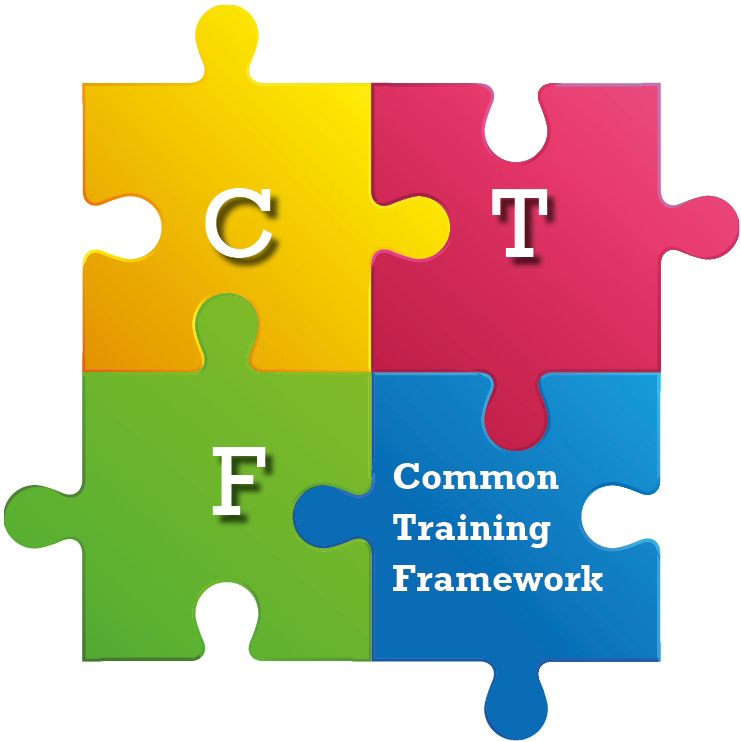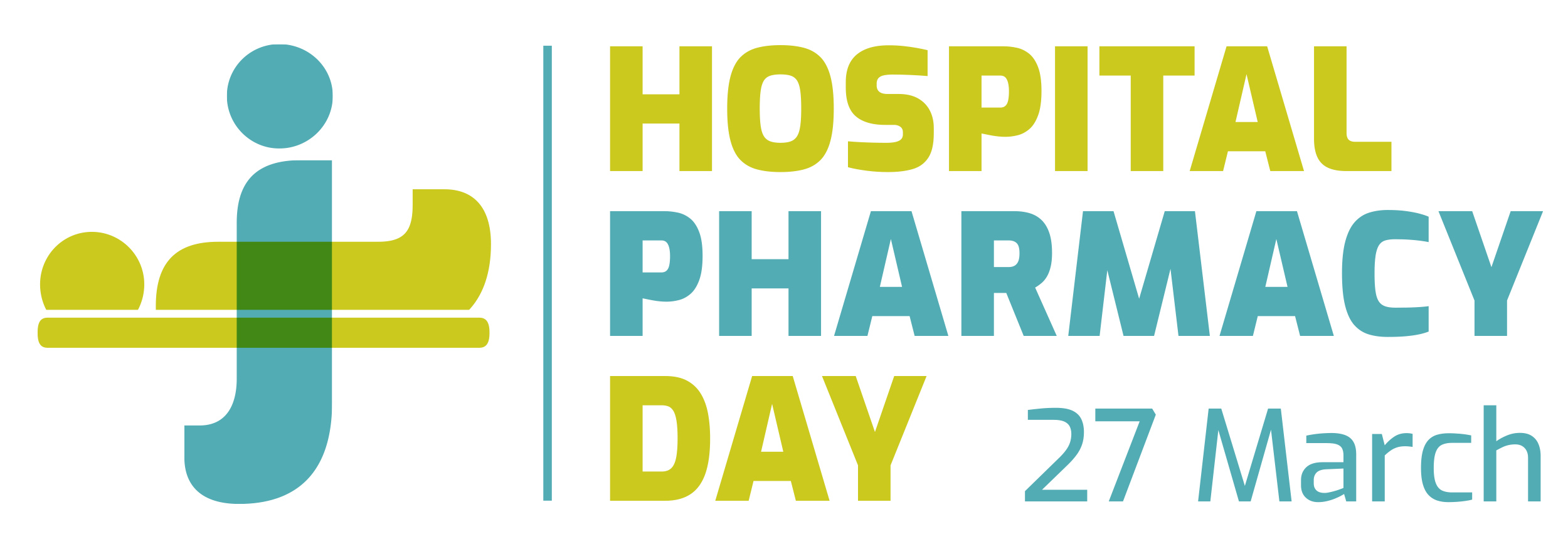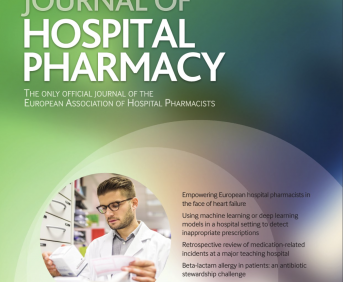IMPLEMENTING A NEW PHARMACEUTICAL CARE PROCESS IN SURGERY (submitted in 2019)
Pdf

European Statement
Clinical Pharmacy Services
Author(s)
Sarah POGGIO, Anne-Sylvie DUMENIL, Sandrine ROY, Claire HENRY
Why was it done?
BPMH on admission has been performed in these departments since 2011. An analysis of the process and prescriber use of BPMH highlighted an underutilisation; average consultation rate was 29.8%. The main reasons were the online publishing interval of the BMPH and competition with the AC report which also displays medication. A previous study showed a 70% rate of patients with unintended differences between BMPH and the AC report.
What was done?
We redesigned the pharmaceutical care process for programmed patient circuits in orthopaedic and visceral surgery by providing the “best possible medication history” (BPMH) in the patient’s electronical medical record (EMR) before anaesthesia consultation (AC).
How was it done?
Due to a lack of coordination, we exchanged using surgery with anaesthesia schedules to select patients, thus improving prioritisation. We created support documents for students, describing how to conduct a phone interview in order to reassure unfamiliar patients, to gather useful data (GP, pharmacy, prescription) to produce a BPMH, to visit inpatients when admitted to confirm the BPMH’s accuracy and to assess patient satisfaction with the process. We trained 6 students and presented our work at an anaesthetist staff meeting.
What has been achieved?
Among 195 patients included from June to October 2019, 70.2% BPMH before admission were successfully published online (137/195), 67 went through the complete care path (from home to discharging), 12 never came for AC and/or surgery, 58 were published but waiting for patient’s admission and 58 failed. The reasons we failed to publish on time included inability to reach patients (31.6%), lack of sources (21.1%), time shortage before AC (17.6%), surgery cancellation (14.0%) and refusal (7.3%). 1.58 (±0.85) calls were needed to reach a patient, 13 BPMH required modification after admission (19%), and patient satisfaction on average was 5.11/6 when asked whether the call, the medication management during hospitalisation and the confirmation interview went well. Finally, the consultation rate of BMPH evolved from 29.8% in 2017 to 72% since we changed practices.
What next?
Implementing this new process in the care path streamlines information transfer between the different stakeholders (anaesthetists, surgeons, pharmacists) and provides a better integration of pharmaceutical care in surgery wards as an efficient support system for prescribers.
FOUR YEARS OF A REGIONAL MEDICINES OPTIMISATION INNOVATION CENTRE – WHAT HAS BEEN ACHIEVED? (submitted in 2019)
Pdf

European Statement
Introductory Statements and Governance
Author(s)
Michael Scott, Glenda Fleming, Catherine Harrison
Why was it done?
There is a wide recognition that there are significant issues with regard to the issue of medicines, such as the fact that 30−50% of medicines are not taken as required. Thus the DoH decided to set up MOIC as a vehicle to focus activities in order to address this issue and optimise medicines use.
What was done?
A Regional Medicines Optimisation Innovation Centre (MOIC) was set up in 2015 by the Department of Health (DoH) in Northern Ireland as a key enabler for the Government policy document namely the Medicines Optimisation Quality Framework.
How was it done?
The DoH requested the Northern Health and Social Care Trust to locate the centre within the Trust based on the fact that there had been a long standing academic practice centre with the School of Pharmacy at Queens University of Belfast. Barriers that had to be addressed were highlighting the regional nature of the centre, to get engagement with all sectors of the service and building relationships with other key organisations, including the private sector. Initial core funding was provided by the DoH.
What has been achieved?
MOIC has successfully evaluated improved systems with regard to hospital pharmacy such as doctor-light discharge (90 minutes faster), post-discharge telephone follow-up (30 day readmission rate reduced by 9.9%), and medicines optimisation in older people service in care home settings (reduced Emergency Department attendances and medicines costs). In addition MOIC has been successful in 3 EU funding bids relating to medicines optimisation and has published over 30 papers. It has also been accredited as a Statement Implementation Learning Collaborative Centre (SILCC) site and also a Centre of Excellence by the Spanish Hospital Pharmacists Association. MOIC has also successfully worked with the private sector including pharmaceutical, device and technology companies. It has also been accredited as a knowledge provided by Invest NI.
What next?
MOIC has delivered on its key initial objectives, related to medicines optimisation with good collaborative work across health, academia and commercial organisations, in the UK and Europe. It will have a key role in meeting the WHO Global Challenge of reducing medication-related harm by 50% by 2023 for the region and further optimising medicines systems.
This approach with government policy support could be relatively easily established in any other region.
IMPLEMENTATION OF DRUG RECONCILIATION WITHIN THE DEPARTMENT OF PAEDIATRIC HEMATO-IMMUNOLOGY AT THE UNIVERSITY HOSPITAL CENTER ROBERT DEBRÉ (submitted in 2019)
Pdf

European Statement
Clinical Pharmacy Services
Author(s)
Marguerite VAILLANT, Sophie GUILMIN CREPON, Benoit BRETHON , Julie ROUPRET-SERZEC
Why was it done?
In order to obtain a safe patient care pathway, we wish to implement proactive and/or retroactive DR for patients followed in the Hemato-Immunology Department of the University Hospital Center Robert Debre.
What was done?
Formalise and integrate drug reconciliation (DR). Evaluate the feasibility of the project, the impact of DR on the safety of patient care and the satisfaction of patients and health professionals.
How was it done?
Prospective cohort study. The different steps are: identification of eligible patients, collection of information on the patient’s drug history and ongoing treatments from the health partners involved in his or her care, entry drug reconciliation (EDR) during the entry pharmaceutical consultation, conciliation of exit drugs during the return pharmaceutical consultation, transmission of information to the local center and pharmacist or home hospitalisation, evaluation of stakeholder satisfaction and the impact of the intervention.
What has been achieved?
Thirty patients included between August and October 2019, or 30 conciliations performed. Concerning the EDR: all hospitalisation reports and previous prescriptions are consulted (100%), 6 EDR (20%) take place in pro-active mode, the average duration of an EDR is 43 minutes. Concerning the discharge drug reconciliation (DDR): 30 DDR (100%) take place in pro-active mode, the average duration of a DDR is 52 minutes, all prescriptions and intake plans are sent to community centres and pharmacists or home hospitalisation (100%). Of all the conciliations performed: 4 sources of information used by conciliation, 11 drugs prescribed on average per prescription, 8 intentional and 6 unintentional discrepancies identified by prescription. Concerning the evaluation of satisfaction: all community centres are satisfied (100%), 26 city professionals (87%), 21 hospital professionals (70%), 27 patients (90%).
What next?
In order to ensure that DR is permanently included in the service, a communication and information tool must be developed. This, made available to the entire team, will serve as a traceability support, decompartmentalise practices and improve patient care.
IMPLANTATION OF A COMMUNICATION CIRCUIT OF ALERTS AND SAFETY NOTES RELATED TO DRUGS FROM THE PHARMACY DEPARTMENT (submitted in 2019)
Pdf

European Statement
Patient Safety and Quality Assurance
Author(s)
Ignacio García Giménez, Natalia Martín Fernández, Olalla Montero Pérez, Ernesto Sánchez Gómez, Isabel María Carrión Madroñal
Why was it done?
The aim is to implement a protocol to follow when these safety notes/alerts are released from the AEMPS. It comprehends the reception of the information, its registration and its communication, when needed, to the rest of the healthcare professionals.
What was done?
A communication circuit of alerts and safety notes related to drugs coming from the “Agencia Española de Medicamentos y Productos Sanitarios (AEMPS)”.
How was it done?
At the reception of an alert from the AEMPS, the first step is to check if the drug has been acquired by the Pharmacy, and then act in accordance with the recommendations, informing the Departments in which the medication had been dispensed. If a drug must be retired and a stock break is generated, the healthcare professionals must be informed as well. Security notes from the AEMPS are published in the local hospital website, where the documents sent by the AEMPS can be found. If this medication is included in the Pharmacotherapeutic guide, a notification is shown when it is prescribed. Finally, all alerts and security notes, with the pharmacist intervention, are registered in a database.
What has been achieved?
Since the implementation of the circuit, 14 alerts and 9 security notes were sent from the AEMPS in a period of 6 months. No interventions regarding the alerts were needed. Healthcare professionals were informed when the security notes were released, pointing to the patients at risk, the precautions required and the alternative therapies available.
What next?
To incorporate it as an indicator of quality of care within the procedures performed by the pharmacy department and detect areas of improvement.
PATIENT-CENTRED CARE IN ATRIAL FIBRILLATION: AN INTEGRATED MANAGEMENT APPROACH (submitted in 2019)
Pdf

European Statement
Patient Safety and Quality Assurance
Author(s)
virginia Silvari, Suzanne McCarthy , Gerry Allen
Why was it done?
Before its establishment, patients were referred by primary and secondary care physicians to a general cardiology clinic, often resulting in delay of the initial assessment and/or commencement of treatment for AF by the ANP. The HP had no involvement in this care pathway. The AF clinic has shortened the referral pathway for patients; physicians now refer patients directly to the clinic. The HP is responsible for medication optimisation; counselling and education whilst clinicians can focus on clinical examinations, diagnostics and analysis of tests results.
What was done?
The atrial fibrillation (AF) clinic was established in a tertiary referral hospital. The clinic is led by a hospital pharmacist (HP), with expertise in cardiology and anticoagulation, and an advanced nurse practitioner (ANP) specialised in electrophysiology. Cardiologists’ input is available when required. In line with AF guidelines of the European Society of Cardiology (ESC), patients attending the clinic receive full stroke risk assessment and are presented with different treatment options by the Multidisciplinary Team (MDT). These options include heart rate/ rhythm control and stroke prevention and where appropriate DC-cardioversion. Patient’s preferences guide management of the treatment.
How was it done?
Stakeholder engagement was essential in establishing the clinic and planning meetings were used to ensure seamless delivery of the service. Analysis of the process showed that the critical path (bottleneck) was access to diagnostics on the same day of attendance of the patient to the clinic. Therefore, the clinic was established on a day where the cardiac-physiology department had sufficient resources to accommodate the clinic. It was also necessary to ensure allocated time for the ANP and HP to deliver the service.
What has been achieved?
The HP has improved patient safety by conducting medication reviews, in particular optimisation of anticoagulants according to patients’ preferences (warfarin versus direct oral anticoagulants) and their characteristics such as renal functions, body weight and age. HP also provides to the patients a one-to-one counselling session on their medications (focus on anticoagulants), adherence, drug interactions and side effects.
What next?
Having seen the benefits of this AF Clinic and the holistic service it delivers, it is recommended that hospitals establish an AF clinic to provide optimum treatment and prevent AF-related complications.
MULTIDISCIPLINARY CAR-T TEAM (submitted in 2019)
Pdf

European Statement
Clinical Pharmacy Services
Author(s)
MARGHERITA GALASSI, CHIARA DELLA COSTANZA , CLAUDIA TIRONE, SARA BERTOLI, ERNESTO RUFFINO, ELEONORA FERRARI, ELENA ALIPRANDI , VITO LADISA
Why was it done?
CAR-T cell therapies are a new advanced type of personalised immunotherapy against cancer. In the EU the authorised therapies are tisagenlecleucel and axicabtagene ciloleucel, both used in our centre as third line for the registered indication of diffuse large B-cell lymphoma. CAR-T therapies production and administration process consists of multiple stages: patient’s leukapheresis, genetic engineering of lymphocytes, lymphodepleting chemotherapy (LC), CAR-T cell infusion, monitoring of the patient. Considering the complexity of the procedure and the observance of specific schedules, these therapies should be administered in highly specialised centres complying with specific organisational requirements, with disposal of an adequate multidisciplinary team.
What was done?
A multidisciplinary team (CAR-T team) was constituted for the management of CAR-T therapies (Chimeric Antigen Receptor T). The pharmacist was included in the team for the planning and organisational phase of the process.
How was it done?
The pharmacist is responsible for the approval of the physician’s prescription, the LC preparation according to Good Manufacturing Practice (GMP), the LC distribution on scheduled time, the making available of treatments for supporting the patient until CAR-T infusion, and treatments after infusion for management of adverse events. At the arrival of the CAR-T product, the pharmacist is responsible for the check and release of it in good condition. The LC protocols foresee the administration of cyclophosphamide and fludarabine on the 5th, 4th and 3rd day before the CAR-T infusion, and are defined on the basis of the summary-of-product characteristics. The medications are provided locally and refunded by the national health system.
What has been achieved?
In our center 8 patients were treated with compassionate use of axicabtagene ciloleucel. The pharmacist’s presence in the multidisciplinary team was advantageous because, through validation of the therapies and verification of dosages, they guarantee further security to the patients. The high-tech automated centralisation and computerisation of chemotherapies at our centre ensured quality and safety of the preparations.
What next?
The realisation of defined paths and codified proceedings, the respect of fundamental timings for the success of the process and the chemotherapy preparation centralisation could lead to increased investment, decisive for obtaining a high quality product and process level. The experience, now limited to haematology, could be used for future CAR-T applications.
ANTIMICROBIAL STEWARDSHIP: WHAT IF EVERYTHING IS ON YOUR SCREEN? (submitted in 2019)
Pdf

European Statement
Introductory Statements and Governance
Author(s)
Marinos Petrongonas, Maria Fragiadaki, Eleni Rinaki, Leonidas Tzimis
Why was it done?
Implementation of antimicrobial stewardship programmes in hospitals is part of the national strategy to promote prudent use of antimicrobials. As HPs chair stewardship teams, they are responsible for assessing prescription and monitoring antimicrobial use. Designing and developing automated informative tools facilitates HPs in their role.
What was done?
Hospital pharmacists (HPs) designed and developed software tools to support the antibiotic stewardship team’s work. Particular developments were: a) Α PC application (GrAD_calc), in Microsoft Excel, to calculate antimicrobial consumption, instead of ABC_calc tool. GrAD_calc takes advantage of the unique codes for each branded product and transforms aggregated data, provided by the Hospital Information System (HIS), into antibiotic consumption in DDDs/100 occupied bed-days. Results are presented in charts and figures, in a format that enables ease of comparative monitoring over time. b) Necessary indexes of the above calculator and documentation needed as justification for restricted antimicrobials dispensing have been integrated into the HIS; in result, data for national surveillance programme for antimicrobial consumption are automatically exported. Useful information for pre- and post-prescription review, like demographics, indication(s), co-morbidities, current and previous treatments, microbiology tests’ results, susceptibility reports, is available and easily accessible to prescribers, HPs, and infection disease specialists.
How was it done?
HPs created GrAD_calc on their own resources, while changes in HIS were made by ICT service provider, following technical specifications described by HPs. A number of technical problems have been resolved with the contribution of HPs.
What has been achieved?
• Monitoring of antimicrobial use by pharmacy is quicker and effortless. • Handwritten documentation included in restricted antimicrobials’ prescriptions has been replaced by an electronic decision support system, as tool to improve antimicrobial prescribing and stewardship. • Useful information from patient’s medical record is directly available to HPs and physicians, and facilitates hospital’s policy for assessing antimicrobial prescriptions. • Data, like indication, medicine, dosage scheme, microbiology results and susceptibility reports, are recorded electronically and update patients’ pharmaceutical records, permitting further use for pharmaco-epidemiology studies.
What next?
Next challenge is wide use of tools developed, to optimise pharmaceutical services provided and dispense restricted antibiotics only when accordingly justified. GrAD_calc is applicable in hospital setting and HIS’s tool is incorporated and can be used by all regional hospitals.
DOES RECORDING OF MEDICATION HISTORY BY PHARMAECONOMIST IN THE EMERGENCY DEPARTMENT HAVE AN EFFECT AT OTHER HOSPITAL DEPARTMENTS? (submitted in 2019)
European Statement
Clinical Pharmacy Services
Author(s)
Maria Abrahamsen
Why was it done?
The aim of the initiative was, among others, to study whether MH by a pharmaconomist in the emergency department has positive effects in other departments. Since the majority of hospitalised patients are admitted through the emergency department it is expected that changes related to admission procedures affect other departments in the cases where patients are hospitalised. In theory recording of MH should be easy, due to the use of Shared Medication Record (FMK). FMK is an updated electronic medication list including all prescriptions filled at pharmacies within the last 2 years. In reality, often neither FMK nor the recorded MH is correct. MH recorded by pharmaconomist or pharmacist is implemented in other emergency departments, but the effect in other hospital departments has yet to be documented.
What was done?
At hospitalisation, part of the routine is to record the patient’s medicinal history. We implemented recording of medicinal history (MH) in the emergency department by a pharmaconomist instead of by a doctor.
How was it done?
The pharmaconomist was present at the emergency department weekdays during daytime to record the MH of newly admitted patients. When the pharmaconomists wasn’t present the doctor recorded the MH. To evaluate the effect in other departments, data registered by pharmaconomists at the department of geriatrics about medicinal changes, types of changes and number of patients with changes were used, combined with hospital data about the number of patients in the geriatric department at a given time. Data from 10 months before the initiative was compared with data from the 9 month test period.
What has been achieved?
At the department of geriatrics both the need for medicine changes due to inadequate MH and the number of patients with medicine changes related to inadequate MH was significantly reduced (p 0.05). The proportion of patients with changes was reduced from 43.7% to 36.9% and the number of changes per patient was reduced from 0.65 to 0.49. For both parameters the reduction is seen immediately after implementing MH by a pharmaconomist in the emergency department. The reduction has released time for nurses, doctors and pharmaconomists working outside the emergency department, though it isn’t possible to quantify the amount of released time.
What next?
Incorporation of a specialised professional such as a pharmaconomist early in a hospitalisation gives doctors, nurses and pharmaconomists working outside the emergency department extra time for other tasks. The effect of the initiative depends on the procedures for admissions since it requires that most patients are admitted through one department at the hospital.
INCLUSION OF PHARMACY STUDENTS IN AN INTERPROFESSIONAL TRAINING WARD PLACEMENT FOR HEALTHCARE STUDENTS IN SWEDEN (submitted in 2019)
Pdf

European Statement
Education and Research
Author(s)
Matts Balgård, Maria Swartling, Srebrenka Dobrić, Lena Klarén, Lina Karlsson
Why was it done?
ITWP for healthcare students is established at various teaching hospitals. However, to our knowledge, no such programme in Scandinavia has included pharmacy students. Clinical pharmacy is a growing profession in Sweden and other healthcare students will in the future work alongside clinical pharmacists. Therefore we set out to add pharmacy students to the ITWP team, believing that it would be a valuable experience for them to collaborate and share knowledge with students from other healthcare professions. Equally important, it is a way to promote the pharmacist’s competence and contribution to the multiprofessional healthcare team, prior to graduation.
What was done?
Final year undergraduate pharmacy students, specialising clinical pharmacy, were given the opportunity to spend two weeks of their six months pharmacy practice to participate in an interprofessional training ward placement (ITWP) together with medical, nursing and physiotherapy students. During this two-week clinical placement, the students were collaboratively responsible for managing the care of geriatric inpatients while under supervision of licensed practitioners.
How was it done?
A working group was formed consisting of teachers from the faculty of pharmacy, a student representative and a working clinical pharmacist. The group developed the initiative, including among other things, prerequisites, an evaluation plan, a workflow tool for clinical rounds, and suggested tasks for pharmacy students during the placement.
What has been achieved?
The programme has been running for three semesters and 6–8 pharmacy students have participated in the ITWP each semester. The initiative has been evaluated using surveys. Participating pharmacy students expressed gaining new knowledge and better insight into nursing care and the roles of the other professions. Nursing students appreciated the support in medication management and medical students found the pharmacy students to be valuable discussion partners that could challenge their drug-related decisions. Tutors expressed that the pharmacy students brought a beneficial dynamic to the ITWP team.
What next?
The opportunity for students from different professions to work together with a common objective in a real-life setting gives them valuable insight into each other’s professional roles early in their careers. This good practice initiative could be used in other interprofessional training ward placements wishing to involve pharmacy students.
PHARMACEUTICAL ALGORITHMS TO PERFORM MEDICATION PHARMACEUTICAL ANALYSIS (submitted in 2019)
Pdf

European Statement
Patient Safety and Quality Assurance
Author(s)
Arnaud Potier, Béatrice Demoré, Alexandre Dony, Emmanuelle Divoux, Emmanuelle Boschetti, Laure-Anne Arnoux, Cédric Dupont, Jean-Christophe Calvo, David Piney, Virginie Chopard, Nathalie Cretin, Edith Dufay
Why was it done?
Drug iatrogenia costs global health systems $52 billion annually. The third global patient safety challenge aims at reducing the global burden of iatrogenic medication-related harm by 50% within 5 years [1]. Pharmaceutical analysis is a fundamental activity, a regulatory obligation in many countries but remains a challenge. This practice is highly variable. A graphic definition of the target pharmaceutical analysis has been formalised in December 2017 which sets the basis for its digitalisation, effectively implemented since January 2019. The aim is to build a corpus of the most relevant PA to facilitate clinical pharmacist practice.
What was done?
A computerised clinical pharmacy tool is integrated into the health information system of our group of hospitals (5000 beds) to promote efficiency of pharmaceutical analysis in order to improve patient safety. Pharmaceutical algorithms (PA) are conceptualised to improve drug related problems (DRP) detection and their resolution through pharmaceutical intervention (PI) according to a defined conduct to be held: anamnesis of subjective and objective elements of appreciation, DRP characterisation and PI transmission. Pharmaceutical analysis is performed by the use of PharmaClass® (Keenturtle). This software has been interfaced with 5 health data flow of two health facilities (1000 of the 2000 beds were tested): identity and patient flow, medication data, laboratory results examination, medical history, physiological constants. PA are partially encoded as rules in Pharmaclass® that issues alerts analysed by a pharmacist.
How was it done?
Health data are lacking of semantic interoperability which Pharmaclass® aims at overcoming from Electronical health record (EHR) queries in real time. A corpus of PA has been structured integrating the conduct to be held. PA were created by modeling the pharmaceutical experiment with the thread of criticality. PA were validated by consensus.
What has been achieved?
80 PA were encoded into Pharmaclass®: 40 are targeting serious adverse drug events. 1516 alerts were analysed and 539 PI transmitted during the 9-month test period.
What next?
This practice is applicable to any pharmaceutical analysis that uses data from an EHR. Clinical pharmacy societies should host and take care of updating corpus of PA. Its educational interest should be exploited. A European interest group for artificial intelligence in clinical pharmacy is being created.
